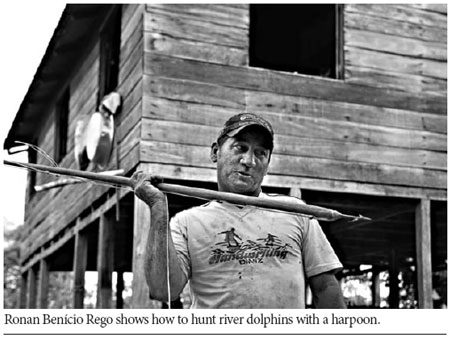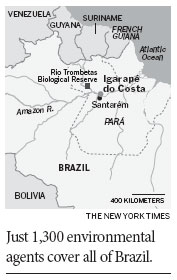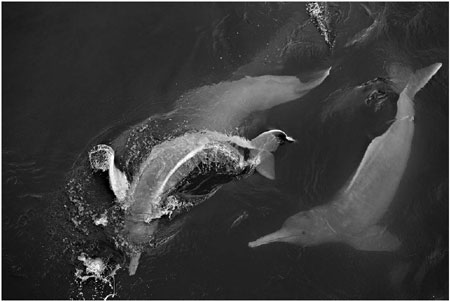Center
Mythic Amazon dolphins at risk
Updated: 2011-04-24 08:04
By Alexei Barrionuevo (New York Times)
|
Tradition says pink dolphins can turn into men and impregnate women. Now, fishermen call them rivals and kill them for bait. Photographs by Lalo De Almeida for The New York Times |

 |
IGARAPe DO COSTA, Brazil - Along the rivers of the Amazon rain forest, people still recount legends in which pink dolphins are magical creatures that can turn into men and impregnate women. Brazilian musicians write songs about them.
But for Ronan Benicio Rego, a fisherman in this tiny settlement, pink dolphins are both rival and prey.
Standing on the muddy banks of the river here, he said he had killed river dolphins many times, to use as bait to catch a catfish that is sold to unknowing consumers in Brazil and Colombia.
"We want to make money," said Mr. Rego, 43, the president of the community here. Two dead dolphins could yield about $2,400 in catfish sales in a single day of fishing, he said.
But bait is not the only objective. Though the pink dolphins are protected by law, the fishermen see them as competitors for the catches that feed their families, and their frustration sometimes boils over.
"I have harpooned some just to be mean," Mr. Rego said.
The illegal slaughtering of dolphins is on the rise here, illustrating the challenge of policing environmental law in such a vast territory, researchers and government officials say. Hundreds, if not thousands, of the estimated 30,000 river dolphins plying the Amazon region are dying every year, they say.
Miguel Migueis, 41, a Portuguese researcher from the Federal University of Western Para who studies river dolphin populations around the city of Santarem, said the killings could lead to their extinction. "They are killing their culture, their folklore," Dr. Migueis said. "They are killing the Amazon."
Several hours upriver from here, in the biological reserve of Rio Trombetas, Dr. Migueis has seen the dolphin population fall to a little over 50 earlier this year from about 250 in 2009.
Brazil's environmental laws prohibit the killing of dolphins. Violators could face up to four years in prison. But enforcement in the vast Amazon is a huge challenge for Ibama, the Brazilian environmental protection agency, which has 1,300 agents covering the entire country. The Brazilian Amazon alone is larger than India.
Luciano Evaristo, the director of environmental protection with Ibama, acknowledged a growing problem with the killing of river dolphins related to high demand in Colombia for the catfish, and he vowed a crackdown.
Yet here in the heart of the Brazilian Amazon, many people are indifferent about the killings. At an open-air market in Santarem, vendors sell genitals removed from dead dolphins as good luck charms for sex and love. Dolphin oil potion, which sells for about $25 a small bottle, is used to treat rheumatism.
At a Santarem fish market, customers said they had no idea fishermen were using dolphins to catch the catfish, known as piracatinga in Brazil. Still, they said protecting dolphins was not a priority.
"I would eat the fish if I knew it ate dolphins because the dolphins are healthy and come from the Amazon River," said Teresa Oliveira, 67.
About a decade ago, overfishing of a popular fish in Colombia called capaz practically wiped out the species, said Fernando Trujillo, the scientific director of the Omacha Foundation, an environmental group in Bogota. Seeking a substitute, processors and vendors began using the piracatinga from Brazil. In Colombia this fish is known as "mota."
Fishermen in Igarape said they got the idea for killing the dolphins from Colombian fishermen. The fishermen submerge a gloved hand into the water holding pieces of dolphin bones. The catfish, attracted by the odor, latch onto the bait.
The fishermen soon discovered that the catfish was a potential bonanza. "In just two hours we would be making 100 reals," Mr. Rego said, more than $60.
In Igarape, fishermen like Edilson Rocha, 58, tell stories of their battles with the dolphins.
"We don't like him; we are his enemy," Mr. Rocha said. "I killed one when I was waiting for the fish to bite," he continued. "He kept coming closer and the fish were leaving, so I harpooned the dolphin. I couldn't stand it anymore."
The New York Times
E-paper

Blowing in the wind
High-Flyers from around the world recently traveled to home of the kite for a very special event.
Image maker
Changing fortunes
Two motherlands
Specials

Urban breathing space
City park at heart of Changchun positions itself as top tourism attraction

On a roll
Auto hub Changchun also sets its sight on taking lead in railway sector

The stage is set
The Edinburgh International Festival will have a Chinese flavor this year.

